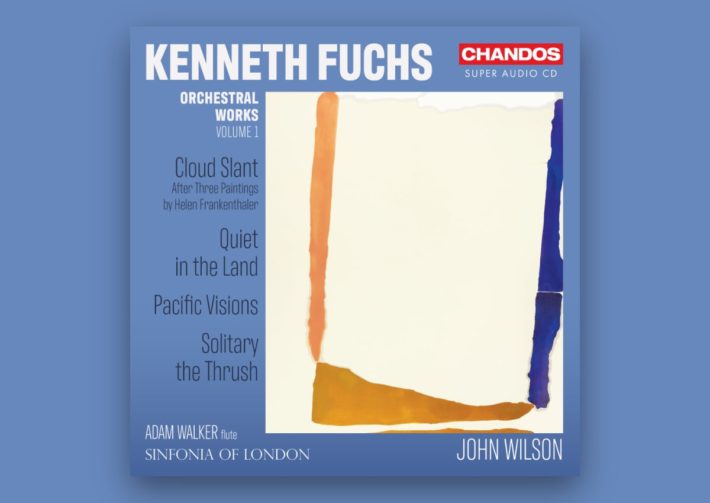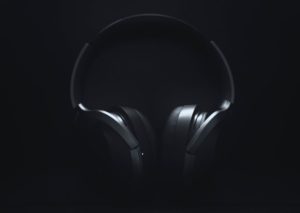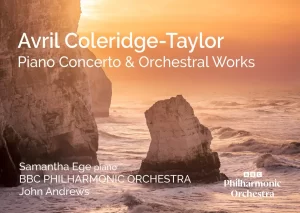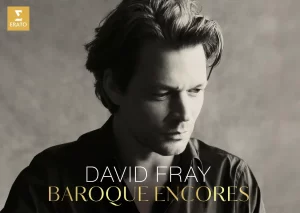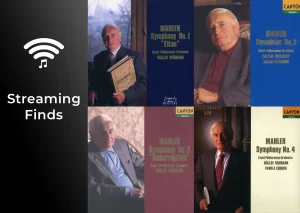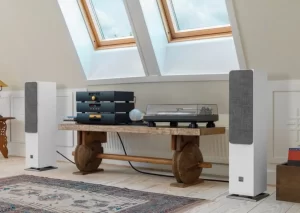Kenneth Fuchs’ music has received enthusiastic advocacy from the Naxos label, with eight albums of his music released in their American Classics series. Six of those are orchestral repertoire played by the London Symphony Orchestra and JoAnn Falletta, all of which have met with consistent acclaim. Now we have this new release on Chandos, featuring John Wilson and the Sinfonia of London in a new series of recordings of Fuchs’ music; all four works receiving their premiere recordings.

See offers for Kenneth Fuchs – Orchestral Works, Vol. 1 by John Wilson on Amazon.
Fuchs is an unapologetically populist composer. This is not to say his music is easy listening, nor to suggest that he simply writes in an always tonal, post-romantic style. In a 2013 interview with Jerry Dubins for Fanfare Magazine, Fuchs states: “I set out to compose music that is colorful and emotionally direct. I employ whatever stylistic elements and technical procedures I need to express my ideas.” That multiplicity of styles and processes, along with a sure sense of form and dazzling orchestration, is readily apparent here.
The program opens with ‘Cloud Slant,’ a three-movement orchestral concerto inspired by three paintings by Helen Frankenthaler: Blue Fall (1966), Flood (1967), and Cloud Slant (1968). The music does not depict the pictures, but rather Fuchs’ emotional reaction to them. He began the work in the 1990s but set it aside incomplete. When John Wilson reached out about this series of recordings, Fuchs finally finished the work with these performers in mind, and its overt virtuosity and rich orchestration seem tailor made for them.
The brightly lit cascading scales and sudden dynamic shift in the opening minutes of ‘Blue Fall’ are vividly evocative, with mild dissonance in the winds as the strings attempt to build the fully-fledged melody that finally arrives at 3’38”. This ushers in a passage of rumination and heart-on-sleeve lyricism, reminiscent of Copland’s ballet scores. The following two movements eschew the opening’s driving propulsion, instead focusing on shifting atmospheres and moods – sample, if you can, the sweeping passion evoked by the duet between the principal horn and the violins (‘Flood,’ Tr. 2/2’05”), its ardent climax answered by a gentle string chorale and burbling woodwinds. The colors in ‘Cloud Slant’ are brighter, the melodic materials more fragmented, but the kaleidoscope of timbral combinations never lets the listener’s attention wander.
Fuchs completed his flute concerto, ‘Solitary the Thrush,’ in January 2020, dedicating it to Peg Luke, for whom it was written. The title refers to lines from Whitman’s ‘When Lilacs Last in the Dooryard Bloom’d,’ the poet’s elegy for Abraham Lincoln. The work opens with the flute imitating bird calls and in dialogue with the woodwinds. The light and transparent orchestration ensures the soloist never struggles to be heard while again offering a constant stream of fluctuating hues and textures. In the second section (the work is one continuous movement that divides into four distinct sections) the warmer alto flute brings greater introspection and a sense of despair. The third section returns to the opening Allegro vivace tempo, the texture more polyphonic, harmonies more astringent. The liner notes suggest this is meant to express the movement from grief’s despair to acceptance. But the concluding section shifts back to a slower tempo in which the harmonies remain tough, the melodic writing increasingly fragmented – resigned acceptance at best. Soloists Adam Walker plays with technical assuredness and beguiling beauty, fully supported by Wilson and his players.
‘Pacific Visions’ for string orchestra follows. Written as a concert opener at the Aquarium of the Pacific in 2017, the single movement work (divided into five sections) opens with an ‘Allegro energico’ of crackling dynamism. After burning itself out, the second section, ‘Cadenza – Larghetto’ begins, its moody, more questioning writing indicating we have reached the emotional heart of the music. (The Sinfonia of London strings are particularly ravishing here.) But the music then picks up speed, bringing a return of complexity and momentum that never really lets up. I found this the least effective work in the program – I wanted more exploration of that slow music, of its more subdued emotions.
The final work, ‘Quiet in the Land’ is far more satisfying. Originally written as a quintet in 2003, at least in part as a response to America’s second Gulf War, this is music that explores far more emotional territory. In 2017 the composer returned to the score, orchestrating it for full orchestra, again in response to the country’s difficult political situation. Those difficulties have not abated, and in many ways are even more disturbing, so I found an immediate connection to this work, its harmonic ambiguity and questioning ending very much representative of the spirit of our time.
The partnership of John Wilson and the Sinfonia of London is a known quantity by now – as expected, the playing is exceptional, every technical hurdle dispatched with disarming ease. Fuchs’s writing plays to Wilson’s strengths: clarity of texture, carefully balanced orchestral color, and exacting precision on articulation and rhythm. The fabulous Chandos sound is richly warm and impressively transparent, the percussion caught especially well. Guy Rickard’s informative and engaging liner notes cap off an easily recommendable album, and one looks forward to the next installment.

Kenneth Fuchs – Orchestral Works, Vol. 1
Sinfonia of London
John Wilson – Conductor
Chandos, CHSA5296

See offers for Kenneth Fuchs – Orchestral Works, Vol. 1 by John Wilson on Amazon.
Related Albums
Spiritualist – Poems of Life | Point of Tranquility | Atlantic Riband | Canticle to the Sun
Included with an Apple Music subscription:
Latest Classical Music Posts
Read more classical music reviews or visit The Classic Review Amazon store
Follow Us and Comment:
[wd_hustle id=”HustlePostEmbed” type=”embedded”]

